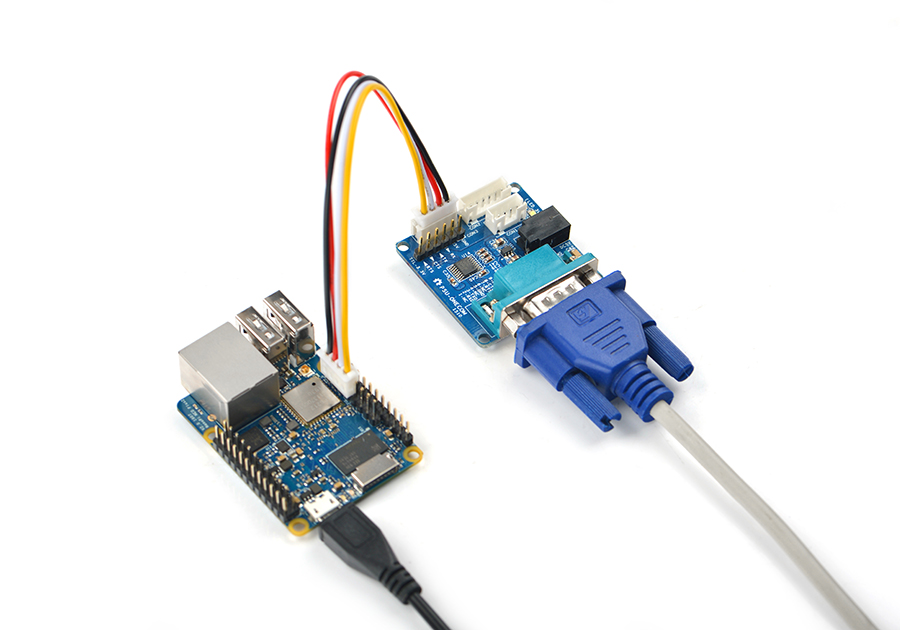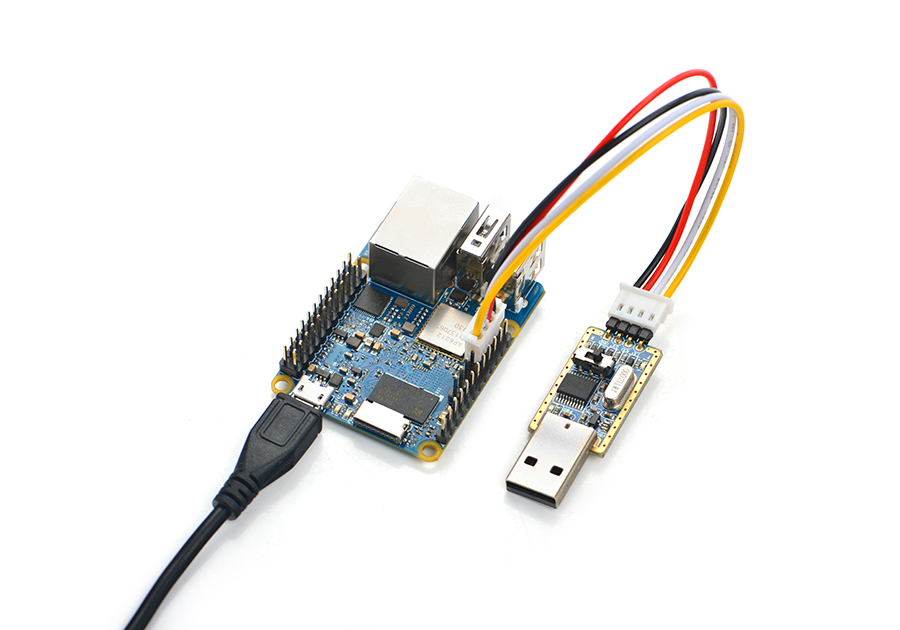Difference between revisions of "Template:FriendlyCoreGeneral/zh"
(→FriendlyCore的使用) |
(→Work with FriendlyCore) |
||
| Line 42: | Line 42: | ||
[[File:npi-config.jpg|frameless|500px|npi-config]]<br /> | [[File:npi-config.jpg|frameless|500px|npi-config]]<br /> | ||
| − | === | + | ===Extend TF Card's Section=== |
| − | + | When FriendlyCore is loaded the TF card's section will be automatically extended.You can check the section's size by running the following command: | |
<syntaxhighlight lang="bash"> | <syntaxhighlight lang="bash"> | ||
| − | df -h | + | $ df -h |
</syntaxhighlight> | </syntaxhighlight> | ||
| − | === | + | ===WiFi=== |
| − | + | You can use the NetworkManager utility in FriendlyCore to manager its network. You can run "nmcli" in the commandline utility to start it. Here are the commands to start a WiFi connection: | |
| − | FriendlyCore | + | * Check device list |
| − | * | + | |
<syntaxhighlight lang="bash"> | <syntaxhighlight lang="bash"> | ||
| − | + | sudo nmcli dev | |
</syntaxhighlight> | </syntaxhighlight> | ||
| − | + | Note: if the status of a device is "unmanaged" it means that device cannot be accessed by NetworkManager. To make is accessed you need to clear the settings under "/etc/network/interfaces" and reboot your system. | |
| − | * | + | * Start WiFi |
<syntaxhighlight lang="bash"> | <syntaxhighlight lang="bash"> | ||
| − | + | sudo nmcli r wifi on | |
</syntaxhighlight> | </syntaxhighlight> | ||
| − | * | + | * Scan Surrounding WiFi Sources |
<syntaxhighlight lang="bash"> | <syntaxhighlight lang="bash"> | ||
| − | + | sudo nmcli dev wifi | |
</syntaxhighlight> | </syntaxhighlight> | ||
| − | * | + | * Connect to a WiFi Source |
<syntaxhighlight lang="bash"> | <syntaxhighlight lang="bash"> | ||
| − | + | sudo nmcli dev wifi connect "SSID" password "PASSWORD" | |
</syntaxhighlight> | </syntaxhighlight> | ||
| − | + | The "SSID" and "PASSWORD" need to be replaced with your actual SSID and password.If you have multiple WiFi devices you need to specify the one you want to connect to a WiFi source with iface<br /> | |
| − | + | If a connection succeeds it will be automatically setup on next system reboot.<br /> | |
<br /> | <br /> | ||
| − | + | For more details about NetworkManager refer to this link: [[Use NetworkManager to configure network settings]]<br /> | |
| − | * | + | * Use USB WiFi |
| − | + | Our OS system has support for popular USB WiFi drivers. Many USB WiFi modules are plug and play with our system. Here is a list of models we tested; | |
::{| class="wikitable" | ::{| class="wikitable" | ||
|- | |- | ||
| − | | | + | |Number||Model |
|- | |- | ||
| − | |1 || RTL8188CUS | + | |1 || RTL8188CUS 802.11n WLAN Adapter |
|- | |- | ||
|2 || RT2070 Wireless Adapter | |2 || RT2070 Wireless Adapter | ||
| Line 90: | Line 89: | ||
|4 || RTL8192CU Wireless Adapter | |4 || RTL8192CU Wireless Adapter | ||
|- | |- | ||
| − | |5 || | + | |5 || mi WiFi mt7601 |
|} | |} | ||
| − | === | + | ===Ethernet Connection=== |
| + | If a board is connected to a network via Ethernet before it is powered on it will automatically obtain an IP with DHCP activated after it is powered up. If you want to set up a static IP refer to: [[Use NetworkManager to configure network settings]]. | ||
| − | + | ===Bluetooth=== | |
| − | + | If your board has an onboard bluetooth module you can search for surrounding bluetooth devices by running the following command:<br/> | |
| − | === | + | |
| − | + | ||
| − | + | ||
<syntaxhighlight lang="bash"> | <syntaxhighlight lang="bash"> | ||
hcitool scan | hcitool scan | ||
</syntaxhighlight> | </syntaxhighlight> | ||
| + | You can run "hciconfig" to check bluetooth's status. | ||
| − | + | ===Play Audio=== | |
| − | + | You can play an audio file by running the following command: | |
| − | + | ||
| − | === | + | |
| − | + | ||
| − | + | ||
<syntaxhighlight lang="bash"> | <syntaxhighlight lang="bash"> | ||
aplay -t raw -c 2 -f S16_LE -r 44100 /root/test.pcm | aplay -t raw -c 2 -f S16_LE -r 44100 /root/test.pcm | ||
</syntaxhighlight> | </syntaxhighlight> | ||
| − | === | + | ===HDMI Audio Output=== |
| − | + | Our system's default audio output is the 3.5mm audio jack. You can turn on the HDMI audio by editing the /etc/asound.conf file: | |
<syntaxhighlight lang="bash"> | <syntaxhighlight lang="bash"> | ||
pcm.!default { | pcm.!default { | ||
| Line 128: | Line 122: | ||
} | } | ||
</syntaxhighlight> | </syntaxhighlight> | ||
| − | card | + | card 0 points to the 3.5mm audio jack and card 1 points to the HDMI audio. You need to save your changes and reboot your system to make your changes take effect. |
| − | === | + | ===Connect to USB Camera(FA-CAM202)=== |
| − | FA- | + | The FA-CAM202 is a 200M USB camera.<br> |
| − | + | Refer to this link for more details on how to connect to a FA-CAM202: | |
| + | [[NanoPi_M1#Connect_NanoPi_M1_to_DVP_Camera_CAM500B|Connect NanoPi M1 to DVP Camera CAM500B]] <br> | ||
| − | === | + | ===Develop Qt Application=== |
| − | + | Please refer to: [[How to build Qt application]] | |
| − | === | + | ===Setup Program to AutoRun=== |
| − | + | You can setup a program to autorun on system boot with npi-config: | |
<syntaxhighlight lang="bash"> | <syntaxhighlight lang="bash"> | ||
sudo npi-config | sudo npi-config | ||
</syntaxhighlight> | </syntaxhighlight> | ||
| − | + | Go to Boot Options -> Autologin -> Qt/Embedded, select Enable and reboot. | |
Revision as of 03:44, 25 December 2017
Contents
1 Work with FriendlyCore
1.1 Introduction
FriendlyCore is a light Linux system without X-windows, based on ubuntu core, It uses the Qt-Embedded's GUI and is popular in industrial and enterprise applications.
Besides the regular Ubuntu core's features our FriendlyCore has the following additional features:
- it supports our LCDs with both capacitive touch and resistive touch(S700, X710, HD702, S430, HD101 and S70)
- it supports WiFi
- it supports Ethernet
- it supports Bluetooth and has been installed with bluez utilities
- it supports audio playing
- it supports Qt5.9 EGLES and OpenGL ES1.1/2.0 (Only for S5P4418/S5P6818)
1.2 FriendlyCore's User Accounts
- If your board is connected to an HDMI monitor you need to use a USB mouse and keyboard.
- If you want to do kernel development you need to use a serial communication board, ie a PSU-ONECOM board, which will allow you to operate the board via a serial terminal.Here is a setup where we connect a board to a PC via the PSU-ONECOM and you can power on your board from either the PSU-ONECOM or its MicroUSB:

You can use a USB to Serial conversion board too.
Make sure you use a 5V/2A power to power your board from its MicroUSB port:

- FriendlyCore User Accounts:
Non-root User:
User Name: pi Password: pi
Root:
User Name: root Password: fa
The system is automatically logged in as "pi". You can do "sudo npi-config" to disable auto login.
- Update packages
$ sudo apt-get update
1.3 Configure System with npi-config
The npi-config is a commandline utility which can be used to initialize system configurations such as user password, system language, time zone, Hostname, SSH switch , Auto login and etc. Type the following command to run this utility.
$ sudo npi-config
Here is how npi-config's GUI looks like:

1.4 Extend TF Card's Section
When FriendlyCore is loaded the TF card's section will be automatically extended.You can check the section's size by running the following command:
$ df -h
1.5 WiFi
You can use the NetworkManager utility in FriendlyCore to manager its network. You can run "nmcli" in the commandline utility to start it. Here are the commands to start a WiFi connection:
- Check device list
sudo nmcli devNote: if the status of a device is "unmanaged" it means that device cannot be accessed by NetworkManager. To make is accessed you need to clear the settings under "/etc/network/interfaces" and reboot your system.
- Start WiFi
sudo nmcli r wifi on- Scan Surrounding WiFi Sources
sudo nmcli dev wifi- Connect to a WiFi Source
sudo nmcli dev wifi connect "SSID" password "PASSWORD"
The "SSID" and "PASSWORD" need to be replaced with your actual SSID and password.If you have multiple WiFi devices you need to specify the one you want to connect to a WiFi source with iface
If a connection succeeds it will be automatically setup on next system reboot.
For more details about NetworkManager refer to this link: Use NetworkManager to configure network settings
- Use USB WiFi
Our OS system has support for popular USB WiFi drivers. Many USB WiFi modules are plug and play with our system. Here is a list of models we tested;
Number Model 1 RTL8188CUS 802.11n WLAN Adapter 2 RT2070 Wireless Adapter 3 RT2870/RT3070 Wireless Adapter 4 RTL8192CU Wireless Adapter 5 mi WiFi mt7601
1.6 Ethernet Connection
If a board is connected to a network via Ethernet before it is powered on it will automatically obtain an IP with DHCP activated after it is powered up. If you want to set up a static IP refer to: Use NetworkManager to configure network settings.
1.7 Bluetooth
If your board has an onboard bluetooth module you can search for surrounding bluetooth devices by running the following command:
hcitool scan
You can run "hciconfig" to check bluetooth's status.
1.8 Play Audio
You can play an audio file by running the following command:
aplay -t raw -c 2 -f S16_LE -r 44100 /root/test.pcm
1.9 HDMI Audio Output
Our system's default audio output is the 3.5mm audio jack. You can turn on the HDMI audio by editing the /etc/asound.conf file:
pcm.!default { type hw card 1 device 0 } ctl.!default { type hw card 1 }
card 0 points to the 3.5mm audio jack and card 1 points to the HDMI audio. You need to save your changes and reboot your system to make your changes take effect.
1.10 Connect to USB Camera(FA-CAM202)
The FA-CAM202 is a 200M USB camera.
Refer to this link for more details on how to connect to a FA-CAM202:
Connect NanoPi M1 to DVP Camera CAM500B
1.11 Develop Qt Application
Please refer to: How to build Qt application
1.12 Setup Program to AutoRun
You can setup a program to autorun on system boot with npi-config:
sudo npi-configGo to Boot Options -> Autologin -> Qt/Embedded, select Enable and reboot.